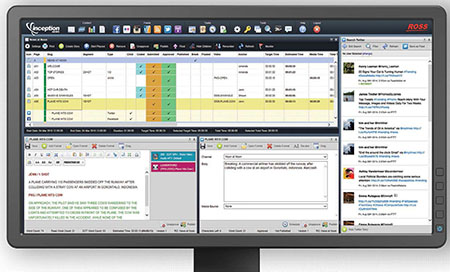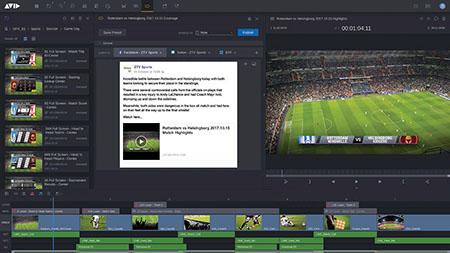Newsrooms Eye Smart Cloud Processing
HAMILTON, N.J.—As news organizations settle into life on file-based IP workflows, their next quantum leap is on the horizon. It’s the cloud—the same cloud that’s already beckoning their media asset management, ingest and playout operations.
By leveraging the cloud’s media processing and storage capabilities, newsrooms can have greater production elasticity and scalability to ramp up or scale back as productivity demands. And cloud platforms make content contribution and remote collaboration easier, especially from mobile devices, while putting newsrooms closer to the social media, OTT services, and other online destinations they increasingly feed.
While top newsroom vendors are building out their platforms with the cloud in mind, they recognize that broadcasters won’t make the leap without assurances that their internet access will be sufficiently robust and reliable, and that their valuable assets will be secure from internet threats.
Despite these challenges, newsrooms will likely be enticed by smart cloud processing, such as artificial intelligence (AI) and cognitive services, like facial and voice recognition, that will make it easier for them to mine the media gems their newscasts require.

Ross Video Inception can be purchased and run on local hardware, in a virtualized environment or in the cloud.
NEWSROOMS OF THE FUTURE
“Futuristic capabilities, such as AI and cognitive services, have the potential to really enrich the news product and further streamline the news production process,” said Raoul Cospen, business development manager for Dalet Digital Media Systems. “But this intensive processing requires accelerated, scalable computer power that is best found in the cloud. To do this on premises would require a massive server farm to perform AI and cognitive processes on huge datasets. We also need to teach machines what we want them to do, such as identifying specific individuals, voices, locations, foreign languages and other aspects of media in large databases.”
The company expects to move users of its Dalet Galaxy-powered unified news operations solution into the cloud step-by-step, starting with such “bread and butter” tasks as ingest, storage and disaster recovery. This incremental approach means that Dalet Galaxy can be configured on premises, in the Amazon Web Services (AWS) public cloud or a hybrid of both.
Get the TV Tech Newsletter
The professional video industry's #1 source for news, trends and product and tech information. Sign up below.
“We at Dalet believe that newsrooms will inevitably migrate to the cloud because of its many operational benefits,” Cospen said. “But we’re mindful of security concerns. We’ve spent the past four years refining our security features and testing our platform’s resilience to hackers and other unauthorized access. We’re confident that we’ve solved that, and other cloud challenges, and we’re forging ahead with what we’re calling our ‘Newsroom of the Future’ roadmap.”
Trevor Francis, director of production systems for U.K.-based SAM also believes that the cloud holds the key to unlocking today’s newsroom potential.
“Newsrooms gain spontaneous scaling of systems relative to productivity demands when they deploy the SAM VIBE news and sports production system in a virtualized, public or private cloud configuration,” he said. And since SAM VIBE freely mixes content from any source and technical standard, he adds, “This gives newsrooms the ability to respond more rapidly to breaking news, while maintaining a competitive presence on social media and other non-TV platforms.”
If a broadcast news organization is not actively publishing its branded content to leading social media and web platforms, Francis said, “They could be dead in a matter of months. This is because the consumer will look elsewhere for another news supplier that does provide the news they want on their preferred platforms.” SAM VIBE uses MOS control to interface with most newsroom systems, he said.
According to Francis, today’s new consumers view news from dozens, if not hundreds of online sites, smartphones, tablets, TVs, laptops and other mobile devices. This often requires mixing standard video with non-standard video formats in their native orientation and aspect ratio into the final product. SAM VIBE “makes it easier for broadcasters to publish their branded content optimized for mobile consumption,” he said.
“This capability is especially important because the first images of hurricanes, accidents, terror incidents and other unexpected events are likely to be shot by people that happen to be there with cell phones, well before the news crews arrive,” Francis added.

Avid MediaCentral Cloud UX provides access to projects, tasks, media and more across MediaCentral through a simple user-friendly graphical interface, available as a web client and as mobile apps for iOS and Android devices.
DEEP SEARCH
With the explosion of content inundating today’s newsrooms, “News organizations need scalable, flexible, enterprise-class solutions that help them efficiently gather and manage it, as well as distribute it wherever it needs to go,” said Ray Thompson, director of broadcast and media solutions market for Avid.
By delivering Microsoft Azure cloud-certified and cloud-native newsroom solutions and IP-workflows, Thompson said that Avid is enabling newsrooms to move quickly and handle a broader range of IP content and tasks. This includes browser-based search and access to a deep, indexed library of content, locally and across the group, while extending newsroom resources and workflows to field reporters.
“The cloud is also essential to aggregating and leveraging user-generated content in a way that makes newscasts more relevant, engaging and personalized for viewers,” Thompson said.
MediaCentral users can add modules—such as MediaCentral l Newsroom Management and MediaCentral l Asset Management—to the base platform to tailor it to their workflow. According to Thompson, this enables them to take advantage of the scalability, collaboration and accessibility that MediaCentral running in a hybrid, public or private cloud affords. Users can also augment their workflows with MediaCentral l Graphics Management to enable journalists to add graphics using the MediaCentral web UI, and expand production and editorial collaboration across heterogeneous editing environments.
In the future, Thompson said, “Media- Central will have increased analytics, artificial intelligence and other advanced capabilities that will help news organizations deal with the explosion of media they need to manage to deliver a personalized consumer experience on any device.”
DEALING WITH SOCIAL CONTENT
Well-functioning newsrooms depend on the flexibility and reliability of existing workflows, so transitioning to new capabilities in cloud-based environments takes time and agility, according to Drew Martin, product manager of GV STRATUS for Grass Valley. “It’s not realistic to expect TV news teams to completely up-end their complex workflows, and jump into the deep end with an all-new cloud or virtualized-based workflows,” he said. “The key is to allow them to migrate to virtualization and cloud configurations gradually, while maintaining their familiar workflow experience.”
With v6.0 launching in February, Grass Valley is making its GV STRATUS newsroom software extremely modular, moving away from proprietary hardware so users can run it on a less COTS environment. The release also adds the functionality broadcasters need to ingest and manage video from user-generated sources.
At the 2018 NAB Show, Grass Valley will unveil the GV I/O feature, which enables GV STRATUS to support SDI and IP ingest and playout in software or virtualized environments. Combined with GV XRE Transcoder, GV STRATUS will ingest and publish media to a wide range of platforms, while handling different aspect ratios automatically.
Social Media Management, another new GV STRATUS module (coming in early 2018), will enable newsrooms to securely manage their social media posts from a single user interface. “They can also set up rules that automate workflows to ease the burden of maintaining a dynamic social media presence,” Martin said.
FLEXIBLE CONFIGURATIONS
Jenn Jarvis, marketing product manager for Ross Video says it’s unrealistic to have a “one size fits all” mentality about newsroom workflows since customers have unique preferences and want to work in different ways. For example, some larger entities might have sufficient staff, equipment and networking resources to control and manage their own local and/or cloud newsroom, while a start-up with a small team that often works remotely might want to have a newsroom in the cloud that’s managed for them.
“We designed Inception News to meet the needs of every customer so they can work the way they want and be successful doing so,” Jarvis said. “Inception can be purchased and run on local hardware, in a virtualized environment or in the cloud. Our Inception.Cloud subscription service offers the option to rent access and Ross Video will take care of all the maintenance. Since both options use the exact same software, it means customers can easily change and adapt as their needs change.”
While Ross Video currently runs its Inception.Cloud subscription service on AWS, the software also runs in other popular cloud services including Google and Microsoft.

